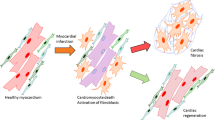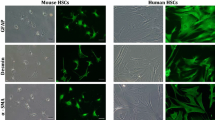Abstract
Hepatic tissue repair plays a critical role in determining the outcome of hepatic ischemia–reperfusion (I/R) injury. Hepatic lymphatics participate in the clearance of dead tissues and contribute to the reparative process after acute hepatic injury; however, it remains unknown whether lymphangiogenesis in response to hepatic inflammation is involved in liver repair. Herein, we determined if hepatic lymphangiogenesis improves liver repair after hepatic I/R injury. Using a mouse model of hepatic I/R injury, we investigated hepatic lymphatic structure, growth, and function in injured murine livers. Hepatic I/R injury enhanced lymphangiogenesis around the portal tract and this was associated with increased expression of pro-lymphangiogenic growth factors including vascular endothelial growth factor (VEGF)-C and VEGF-D. Recombinant VEGF-D treatment facilitated liver repair in association with the expansion of lymphatic vessels and increased expression of genes related to the reparative macrophage phenotype. Treatment with a VEGF receptor 3 (VEGFR3) inhibitor suppressed liver repair, lymphangiogenesis, drainage function, and accumulation of VEGFR3-expressing reparative macrophages. VEGF-C and VEGF-D upregulated expression of genes related to lymphangiogenic factors and the reparative macrophage phenotype in cultured macrophages. These results suggest that activation of VEGFR3 signaling increases lymphangiogenesis and the number of reparative macrophages, both of which play roles in liver repair. Expanded lymphatics and induction of reparative macrophage accumulation may be therapeutic targets to enhance liver repair after hepatic injury.






Similar content being viewed by others
Abbreviations
- ALT:
-
Alanine aminotransferase
- BM:
-
Bone marrow
- BMM:
-
Bone marrow-derived macrophage
- GAPDH:
-
Glyceraldehyde-3-phosphate dehydrogenase
- H&E:
-
Hematoxylin and eosin
- IL:
-
Interleukin
- i.p.:
-
Intraperitoneal
- I/R:
-
Ischemia–reperfusion
- LVA:
-
Lymphatic vessel area
- LVD:
-
Lymphatic vessel density
- LYVE:
-
Lymphatic vessel endothelial hyaluronan receptor
- MR:
-
Mannose receptor
- MVA:
-
Microvessel area
- MVD:
-
Microvessel density
- PBS:
-
Phosphate-buffered saline
- PCNA:
-
Proliferating cell nuclear antigen
- SD:
-
Standard deviation
- TNF:
-
Tumor necrosis factor
- VEGF:
-
Vascular endothelial growth factor
- VEGFR3:
-
Vascular endothelial growth factor receptor 3
References
Clavien PA, Petrowsky H, DeOliveira ML, Graf R (2007) Strategies for safer liver surgery and partial liver transplantation. N Engl J Med 356:1545–1559
Lentsch AB (2012) Regulatory mechanisms of injury and repair after hepatic ischemia/reperfusion. Scientifica 2012:513192. https://doi.org/10.6064/2012/513192
Alitalo K (2011) The lymphatic vasculature in disease. Nat Med 17(11):1371–1380. https://doi.org/10.1038/nm.2545
Kang S, Lee SP, Kim KE, Kim HZ, Memet S, Koh GY (2009) Toll-like receptor 4 in lymphatic endothelial cells contributes to LPS-induced lymphangiogenesis by chemotactic recruitment of macrophages. Blood 113:2605–2613. https://doi.org/10.1182/blood-2008-07-166934
Dieterich LC, Seidel CD, Detmar M (2014) Lymphatic vessels: new targets for the treatment of inflammatory diseases. Angiogenesis 17:359–371. https://doi.org/10.1007/s10456-013-9406-1
Kaipainen A, Korhonen J, Mustonen T, van Hinsbergh VW, Fang GH, Dumont D, Breitman M, Alitalo K (1995) Expression of the fms-like tyrosine kinase 4 gene becomes restricted to lymphatic endothelium during devel-opment. Proc Natl Acad Sci USA 92:3566–3570
Tammela T, Zarkada G, Wallgard E, Murtomäki A, Suchting S, Wirzenius M, Waltari M, Hellström M, Schomber T, Peltonen R, Freitas C, Duarte A, Isoniemi H, Laakkonen P, Christofori G, Ylä-Herttuala S, Shibuya M, Pytowski B, Eichmann A, Betsholtz C, Alitalo K (2008) Blocking VEGFR-3 suppresses angiogenic sprouting and vascular network formation. Nature 454:656–660. https://doi.org/10.1038/nature07083
D’Alessio S, Correale C, Tacconi C, Gandelli A, Pietrogrande G, Vetrano S, Genua M, Arena V, Spinelli A, Peyrin-Biroulet L, Fiocchi C, Danese S (2014) VEGF-C-dependent stimulation of lymphatic function ameliorates experimental inflammatory bowel disease. J Clin Invest 124:3863–3878. https://doi.org/10.1172/JCI72189
Zhang Y, Lu Y, Ma L, Cao X, Xiao J, Chen J, Jiao S, Gao Y, Liu C, Duan Z, Li D, He Y, Wei B, Wang H (2014) Activation of vascular endothelial growth factor receptor-3 in macrophages restrains TLR4-NF-κB signaling and protects against endotoxin shock. Immunity 40:501–514. https://doi.org/10.1016/j.immuni.2014.01.013
Kataru RP, Jung K, Jang C, Yang H, Schwendener RA, Baik JE, Han SH, Alitalo K, Koh GY (2009) Critical role of CD11b+ macrophages and VEGF in inflammatory lymphangiogenesis, antigen clearance, and inflammation resolution. Blood 113:5650–5659. https://doi.org/10.1182/blood-2008-09-176776
Huggenberger R, Siddiqui SS, Brander D, Ullmann S, Zimmermann K, Antsiferova M, Werner S, Alitalo K, Detmar M (2011) An important role of lymphatic vessel activation in limiting acute inflammation. Blood 117:4667–4678. https://doi.org/10.1182/blood-2010-10-316356
Kim H, Kataru RP, Koh GY (2014) Inflammation-associated lymphangiogenesis: a double-edged sword? J Clin Invest 124:936–942. https://doi.org/10.1172/JCI71607
Vollmar B, Wolf B, Siegmund S, Katsen AD, Menger MD (1997) Lymph vessel expansion and function in the development of hepatic fibrosis and cirrhosis. Am J Pathol 151:169–175
Yamauchi Y, Michitaka K, Onji M (1998) Morphometric analysis of lymphatic and blood vessels in human chronic viral liver diseases. Am J Pathol 153:1131–1137
Tamburini BAJ, Finlon JM, Gillen AE, Kriss MS, Riemondy KA, Fu R, Schuyler RP, Hesselberth JR, Rosen HR, Burchill MA (2019) Chronic liver disease in humans causes expansion and differentiation of liver lymphatic endothelial cells. Front Immunol 10:1036. https://doi.org/10.3389/fimmu.2019.01036
Tanaka M, Iwakiri Y (2018) Lymphatics in the liver. Curr Opin Immunol 53:137–142. https://doi.org/10.1016/j.coi.2018.04.028
Nishizawa N, Ito Y, Eshima K, Ohkubo H, Kojo K, Inoue T, Raouf J, Jakobsson PJ, Uematsu S, Akira S, Narumiya S, Watanabe M, Majima M (2018) Inhibition of microsomal prostaglandin E synthase-1 facilitates liver repair after hepatic injury in mice. J Hepatol 69:110–120. https://doi.org/10.1016/j.jhep.2018.02.009
Benedito R, Rocha SF, Woeste M, Zamykal M, Radtke F, Casanovas O, Duarte A, Pytowski B, Adams RH (2012) Notch-dependent VEGFR3 upregulation allows angiogenesis without VEGF-VEGFR2 signalling. Nature 484:110–114. https://doi.org/10.1038/nature10908
Mishima T, Ito Y, Nishizawa N, Amano H, Tsujikawa K, Miyaji K, Watanabe M, Majima M (2017) RAMP1 signaling improves lymphedema and promotes lymphangiogenesis in mice. J Surg Res 2017 219:50–60. https://doi.org/10.1016/j.jss.2017.05.124
Barbier L, Tay SS, McGuffog C, Triccas JA, McCaughan GW, Bowen DG, Bertolino P (2012) Two lymph nodes draining the mouse liver are the preferential site of DC migration and T cell activation. J Hepatol 57:352–358. https://doi.org/10.1016/j.jhep.2012.03.023
Kato T, Ito Y, Hosono K, Suzuki T, Tamaki H, Minamino T, Kato S, Sakagami H, Shibuya M, Majima M (2011) Vascular endothelial growth factor receptor-1 signaling promotes liver repair through restoration of liver microvasculature after acetaminophen hepatotoxicity. Toxicol Sci 120:218–229. https://doi.org/10.1093/toxsci/kfq366
Tanaka M, Iwakiri Y (2016) The hepatic lymphatic vascular system: structure, function, markers, and lymphangiogenesis. Cell Mol Gastroenterol Hepatol 2:733–749. https://doi.org/10.1016/j.jcmgh.2016.09.002
Yokomori H, Oda M, Kaneko F, Kawachi S, Tanabe M, Yoshimura K, Kitagawa Y, Hibi T (2010) Lymphatic marker podoplanin/D2-40 in human advanced cirrhotic liver–re-evaluations of microlymphatic abnormalities. BMC Gastroenterol 10:131. https://doi.org/10.1186/1471-230X-10-131
Oikawa H, Masuda T, Sato S, Yashima A, Suzuki K, Sato S, Satodate R (1998) Changes in lymph vessels and portal veins in the portal tract of patients with idiopathic portal hypertension: a morphometric study. Hepatology 27:1607–1610
Matsuda H, Hosono K, Tsuru S, Kurashige C, Sekiguchi K, Akira S, Uematsu S, Okamoto H, Majima M (2015) Roles of mPGES-1, an inducible prostaglandin E synthase, in enhancement of LPS-induced lymphangiogenesis in a mouse peritonitis model. Life Sci 142:1–7. https://doi.org/10.1016/j.lfs.2015.10.008
Hosono K, Suzuki T, Tamaki H, Sakagami H, Hayashi I, Narumiya S, Alitalo K, Majima M (2011) Roles of prostaglandin E2-EP3/EP4 receptor signaling in the enhancement of lymphangiogenesis during fibroblast growth factor-2-induced granulation formation. Arterioscler Thromb Vasc Biol 31:1049–1058. https://doi.org/10.1161/ATVBAHA.110.222356
Hosono K, Isonaka R, Kawakami T, Narumiya S, Majima M (2016) Signaling of prostaglandin E receptors, EP3 and EP4 facilitates wound healing and lymphangiogenesis with enhanced recruitment of M2 macrophages in mice. PLoS ONE 11:e0162532. https://doi.org/10.1371/journal.pone.0162532
Okizaki S, Ito Y, Hosono K, Oba K, Ohkubo H, Kojo K, Nishizawa N, Shibuya M, Shichiri M, Majima M (2016) Vascular endothelial growth factor receptor type 1 signaling prevents delayed wound healing in diabetes by attenuating the production of IL-1β by recruited macrophages. Am J Pathol 186:1481–1498. https://doi.org/10.1016/j.ajpath.2016.02.014
Kim KE, Koh YJ, Jeon BH, Jang C, Han J, Kataru RP, Schwendener RA, Kim JM, Koh GY (2009) Role of CD11b+ macrophages in intraperitoneal lipopolysaccharide-induced aberrant lymphangiogenesis and lymphatic function in the diaphragm. Am J Pathol 175:1733–1745. https://doi.org/10.2353/ajpath.2009.090133
Zgraggen S, Ochsenbein AM, Detmar M (2013) An important role of blood and lymphatic vessels in inflammation and allergy. J Allergy 2013:672381. https://doi.org/10.1155/2013/672381
Henri O, Pouehe C, Houssari M, Galas L, Nicol L, Edwards-Lévy F, Henry JP, Dumesnil A, Boukhalfa I, Banquet S, Schapman D, Thuillez C, Richard V, Mulder P, Brakenhielm E (2016) Selective stimulation of cardiac lymphangiogenesis reduces myocardial edema and fibrosis leading to improved cardiac function following myocardial infarction. Circulation 133:1484–1497. https://doi.org/10.1161/CIRCULATIONAHA.115.020143 (discussion 1497)
Paavonen K, Puolakkainen P, Jussila L, Jahkola T, Alitalo K (2000) Vascular endothelial growth factor receptor-3 in lymphangiogenesis in wound healing. Am J Pathol 156:1499–1504
Mäkinen T, Veikkola T, Mustjoki S, Karpanen T, Catimel B, Nice EC, Wise L, Mercer A, Kowalski H, Kerjaschki D, Stacker SA, Achen MG, Alitalo K (2001) Isolated lymphatic endothelial cells transduce growth, survival and migratory signals via the VEGF-C/D receptor VEGFR-3. Embo J 20:4762–4773
Guo R, Zhou Q, Proulx ST, Wood R, Ji RC, Ritchlin CT, Pytowski B, Zhu Z, Wang YJ, Schwarz EM, Xing L (2009) Inhibition of lymphangiogenesis and lymphatic drainage via vascular endothelial growth factor receptor 3 blockade increases the severity of inflammation in a mouse model of chronic inflammatory arthritis. Arthritis Rheum 60:2666–2676. https://doi.org/10.1002/art.24764
Baluk P, Tammela T, Ator E, Lyubynska N, Achen MG, Hicklin DJ, Jeltsch M, Petrova TV, Pytowski B, Stacker SA, Yl€a-Herttuala S, Jackson DG, Alitalo K, McDonald DM (2005) Pathogenesis of persistent lymphatic vessel hyperplasia in chronic airway inflammation. J Clin Invest 115:247–257
Ding BS, Nolan DJ, Butler JM, James D, Babazadeh AO, Rosenwaks Z, Mittal V, Kobayashi H, Shido K, Lyden D, Sato TN, Rabbany SY, Rafii S (2010) Inductive angiocrine signals from sinusoidal endothelium are required for liver regeneration. Nature 468:310–315. https://doi.org/10.1038/nature09493
Tacconi C, Ungaro F, Correale C, Arena V, Massimino L, Detmar M, Spinelli A, Carvello M, Mazzone M, Oliveira AI, Rubbino F, Garlatti V, Spanò S, Lugli E, Colombo FS, Malesci A, Peyrin-Biroulet L, Vetrano S, Danese S, D’Alessio S (2019) Activation of the VEGFC/VEGFR3 pathway induces tumor immune escape in colorectal cancer. Cancer Res 79(16):4196–4210. https://doi.org/10.1158/0008-5472
Krenkel O, Tacke F (2017) Liver macrophages in tissue homeostasis and disease. Nat Rev Immunol 17:306–321. https://doi.org/10.1038/nri.2017.11
Ohkubo H, Ito Y, Minamino T, Eshima K, Kojo K, Okizaki S, Hirata M, Shibuya M, Watanabe M, Majima M (2014) VEGFR1-positive macrophages facilitate liver repair and sinusoidal reconstruction after hepatic ischemia/reperfusion injury. PLoS ONE 9:e105533. https://doi.org/10.1371/journal.pone.0105533
Acknowledgements
We thank Michiko Ogino and Kyoko Yoshikawa for their technical assistance. This research was supported by research Grants (18K16373, 18K15760 18H02605, and 19K09156) from the Japanese Ministry of Education, Culture, Sports, Science, and Technology and by a Project Research Grant from the Graduate School of Medical Sciences, Kitasato University.
Author information
Authors and Affiliations
Corresponding author
Ethics declarations
Conflict of interest
The authors have no conflicts of interest to declare.
Ethical approval
All experimental procedures were approved by the Animal Experimentation and Ethics Committee of the Kitasato University School of Medicine (2017-59) and were performed in accordance with the guidelines for animal experiments outlined by the Kitasato University School of Medicine, which are in accordance with the Guidelines for Proper Conduct of Animal Experiments published by the Science Council of Japan. This article does not contain any studies with human participants performed by any of the authors.
Additional information
Publisher's Note
Springer Nature remains neutral with regard to jurisdictional claims in published maps and institutional affiliations.
Electronic supplementary material
Below is the link to the electronic supplementary material.
Rights and permissions
About this article
Cite this article
Nakamoto, S., Ito, Y., Nishizawa, N. et al. Lymphangiogenesis and accumulation of reparative macrophages contribute to liver repair after hepatic ischemia–reperfusion injury. Angiogenesis 23, 395–410 (2020). https://doi.org/10.1007/s10456-020-09718-w
Received:
Accepted:
Published:
Issue Date:
DOI: https://doi.org/10.1007/s10456-020-09718-w




